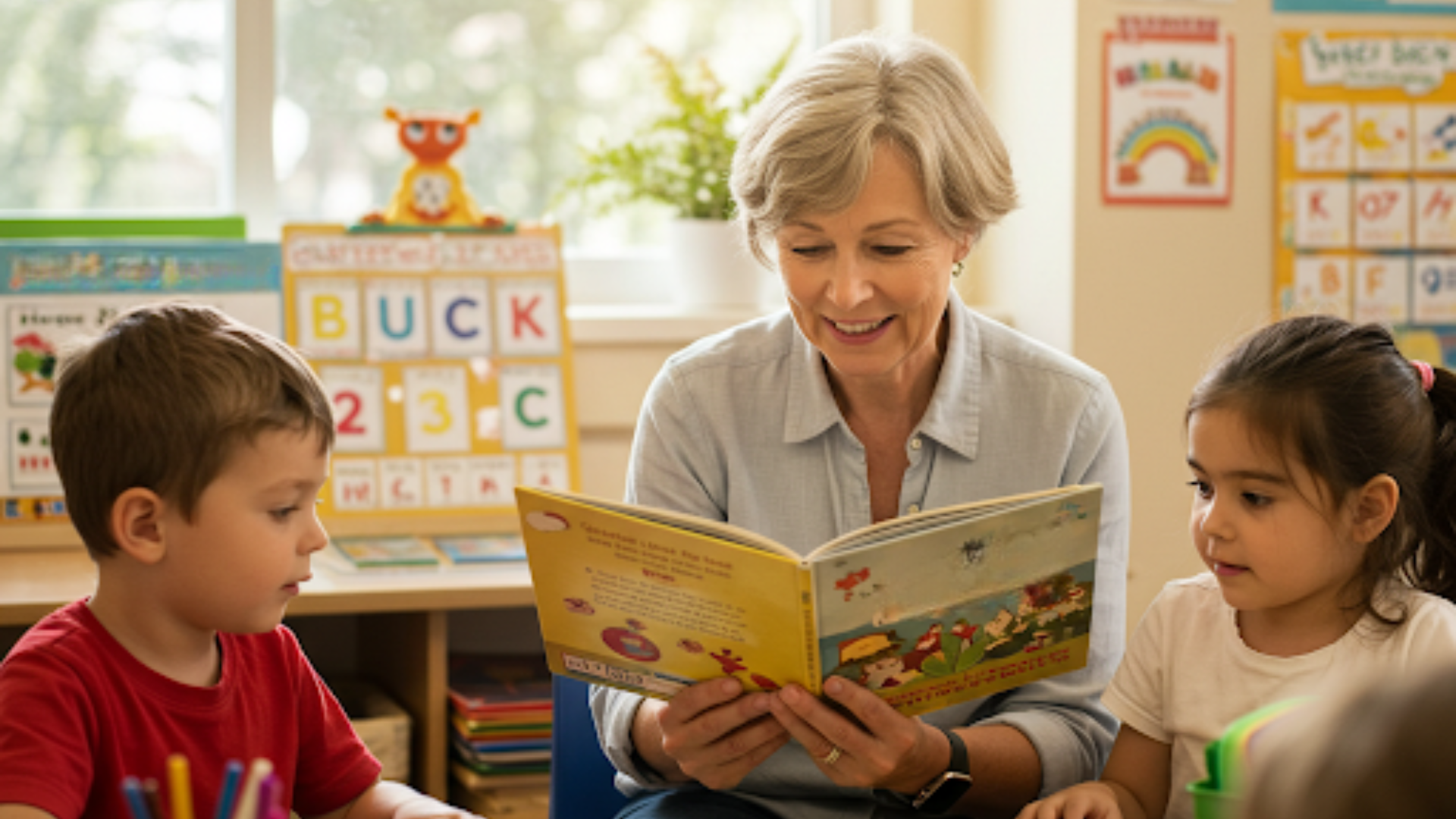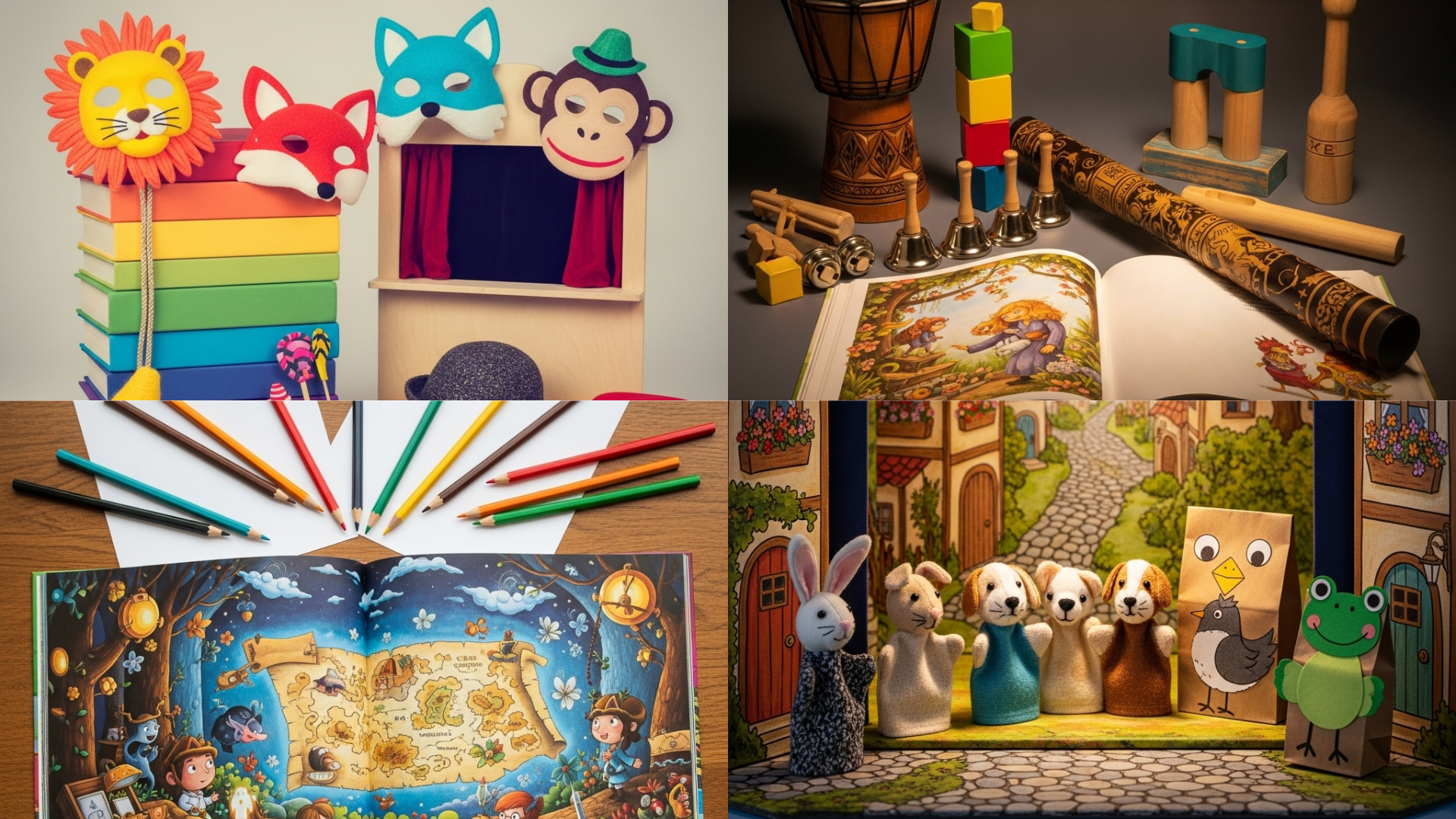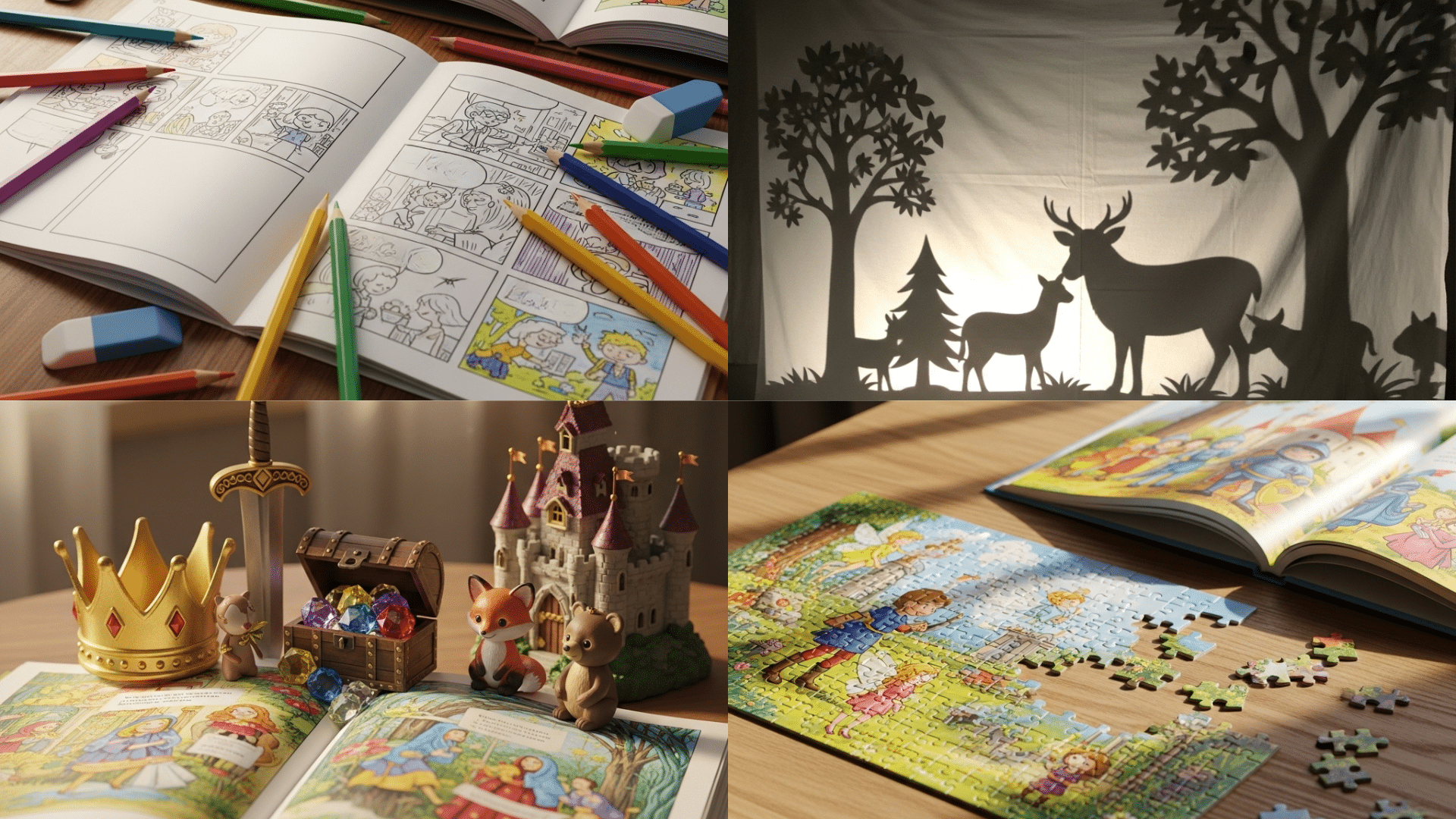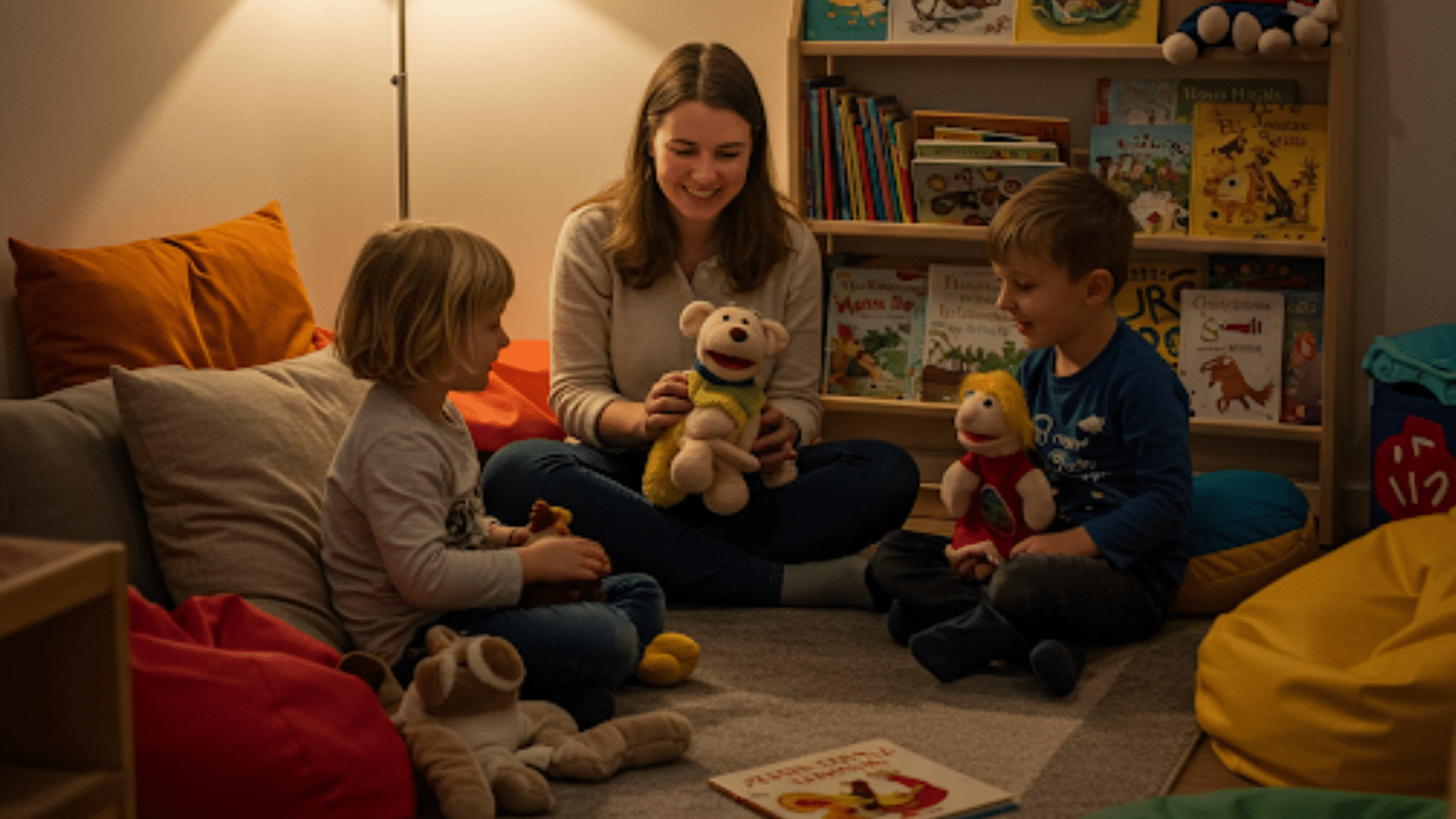Reading to children is crucial, but many parents and teachers struggle to keep young listeners engaged. Kids often lose interest when story time feels too routine.
Read aloud activities can evolve this experience from mundane to magical.
This blog shares effective ways to make story sessions more fun and interactive.
Readers will find simple games, creative exercises, and practical techniques that turn ordinary books into quests, helping adults create meaningful literacy moments that children will cherish.
How Can Read Aloud Activities Upgrades Learning?

When adults read to children, they do more than share stories. Read aloud activities create strong learning moments that help kids grow in many ways. These sessions build skills that serve children both in and out of school.
Children gain these benefits from regular reading sessions:
- Better language skills: Kids hear new words and learn how to use them.
- Stronger attention span: Regular reading helps children focus for longer periods.
- Improved listening: Children learn to catch details and follow stories.
- Higher reading scores: Students who listen to stories often read better themselves.
- Critical thinking growth: Talking about stories helps kids think more deeply.
- Social skills development: Group reading builds turn-taking and sharing.
The bond formed during these reading times also creates a safe space where children feel comfortable asking questions. This helps them become curious learners who aren’t afraid to seek answers.
Creative Read Aloud Activities for Kids
Read aloud activities are a wonderful way to spark children’s imagination and improve their listening and comprehension skills.
When stories are brought to life through interactive and creative methods, kids become more engaged and motivated to participate.
These activities help build vocabulary, encourage critical thinking, and foster a genuine love for reading,
Interactive Storytime Starters

1. Character Voices Challenge
Children enhance the storytelling experience by adopting different voices for each character in the book. This adds theatrical flair and keeps the listeners entertained and engaged.
- What you’ll need: Storybook with rich dialogue
- Ideal age group: 5–10
- Why kids love it: They enjoy the playful performance element.
2. Sound Effect Spectacular
As the story unfolds, children contribute sound effects using household items or instruments to match actions or emotions. This approach makes the story feel more dynamic and immersive.
- What you’ll need: Objects for sound or instruments
- Ideal age group: 4–9
- Why kids love it: It turns reading into an interactive soundscape.
3. Picture Prediction
Before turning the page, children are encouraged to predict what might happen next based on the illustrations. This cultivates curiosity, observation, and inference skills.
- What you’ll need: Picture book
- Ideal age group: 3–7
- Why kids love it: They enjoy guessing what comes next and seeing if they were right.
4. Story Puppets
Puppets are used to act out scenes from the story, giving characters a physical form and making the experience more tactile. This helps reinforce comprehension and boosts creative expression.
- What you’ll need: Finger puppets or paper bag puppets
- Ideal age group: 4–8
- Why kids love it: They get to bring the characters to life.
5. Emotion Expressions
Children act out the emotions of different characters at various story points. This encourages empathy and understanding of emotional nuance.
- What you’ll need: Emotion flashcards or mirrors
- Ideal age group: 5–9
- Why kids love it: It helps them relate to characters on a personal level.
6. Word Detective
Children become “word detectives” by listening for chosen target words throughout the story. This sharpens listening and reinforces vocabulary in a fun and competitive way.
- What you’ll need: List of target vocabulary
- Ideal age group: 5–10
- Why kids love it: They love the challenge of catching each word.
7. Story Sequence Cards
After reading, children place shuffled story scene cards in the correct order. This strengthens memory, comprehension, and narrative flow recognition.
- What you’ll need: Printed scene cards
- Ideal age group: 6–10
- Why kids love it: They enjoy piecing the story puzzle back together.
8. Audience Questions
Throughout the story, the reader asks open-ended questions to the audience. This keeps children thinking critically and encourages participation.
- What you’ll need: Question prompts
- Ideal age group: 4–9
- Why kids love it: They feel heard and involved in the experience.
9. Draw Along
Children draw key scenes or characters from the story as it is being read aloud. This activity boosts visualization skills and creative expression.
- What you’ll need: Drawing paper and crayons
- Ideal age group: 5–10
- Why kids love it: They can visually interpret the story their way.
10. Repeat After Me
Each line or phrase is echoed by the children after the reader delivers it. This helps with language rhythm, pronunciation, and attentive listening.
- What you’ll need: Book with repetitive text
- Ideal age group: 3–6
- Why kids love it: They enjoy the rhythm and being part of the narration
11. Story Soundtrack
Children choose or create music that matches the mood of different story scenes. This activity helps them explore tone and setting through a multisensory lens.
- What you’ll need: Music clips or digital player
- Ideal age group: 6–10
- Why kids love it: They enjoy giving the story a musical heartbeat.
12. Freeze Frame
As a story is read, children freeze in poses that reflect the action or emotion being described. It brings the narrative to life physically and fosters body awareness.
- What you’ll need: Open space for movement
- Ideal age group: 5–9
- Why kids love it: They enjoy acting out moments like statues.
13. Character Dress-Up
Children wear simple costumes or props to embody characters from the story. This activity encourages imaginative play and deeper engagement with character traits.
- What you’ll need: Hats, scarves, or costume items
- Ideal age group: 5–10
- Why kids love it: Dressing up makes the story feel real.
14. Story Map
Children draw a visual map of the story’s setting or plot path. It encourages spatial thinking and reinforces comprehension of the narrative flow.
- What you’ll need: Paper, markers, story details
- Ideal age group: 6–10
- Why kids love it: They enjoy making a visual version of the story world.
15. Fill in the Blanks
The reader leaves out key words during the reading and children fill them in aloud. It helps develop language awareness and active listening.
- What you’ll need: Modified text or cues
- Ideal age group: 5–9
- Why kids love it: They feel clever for completing the story.
16. Predict the Ending
Before reaching the final pages, children are invited to guess how the story will conclude. This builds inferential thinking and anticipation.
- What you’ll need: Storybook
- Ideal age group: 5–10
- Why kids love it: They get to play author for a moment.
17. Story Relay
Multiple children take turns reading sections of the story aloud. This activity promotes collaboration and fluency practice.
- What you’ll need: Storybook with clear parts
- Ideal age group: 6–11
- Why kids love it: They enjoy sharing the spotlight with peers.
18. Soundtrack Creation
Kids design a complete playlist to match story moods or chapters. This activity bridges storytelling and musical interpretation.
- What you’ll need: Music player or playlist app
- Ideal age group: 7–12
- Why kids love it: They love curating soundtracks like a director.
19. Story Bingo
Children listen for key story elements and mark them off on a bingo card. It makes listening more attentive and adds a game element to reading.
- What you’ll need: Bingo cards with story terms
- Ideal age group: 5–9
- Why kids love it: They enjoy the thrill of winning while reading.
20. Shadow Puppets
Children create puppets to cast shadows on a wall while reenacting scenes. It’s a magical, visual storytelling experience that enhances memory and detail.
- What you’ll need: Cutouts, sticks, flashlight
- Ideal age group: 4–8
- Why kids love it: Shadows make everything feel enchanting.
21. Story Character Interviews
Children role-play as interviewers and characters, asking and answering questions. It builds understanding of character motivation and voice.
- What you’ll need: Question cards, props
- Ideal age group: 6–11
- Why kids love it: They enjoy thinking like their favorite characters.
22. Build a Story Scene
Using craft materials or building blocks, children recreate a favorite scene. It adds a hands-on component that reinforces visualization.
- What you’ll need: Blocks, paper, glue, and crafts
- Ideal age group: 5–10
- Why kids love it: They love turning stories into tangible creations.
23. Story Sound Effects Orchestra
Children form groups and are assigned different sound roles for storytelling. They coordinate their sounds to match story actions or scenes.
- What you’ll need: Noisemakers or simple instruments
- Ideal age group: 6–10
- Why kids love it: It feels like being part of a live show.
24. Act It Out
Children perform short scenes or summaries from the story with gestures and dialogue. This promotes expressive language and confidence.
- What you’ll need: Space and props (optional)
- Ideal age group: 6–11
- Why kids love it: They enjoy stepping into the spotlight.
25. Create a Sequel
Children write or tell what happens next after the story ends. It encourages creative thinking and narrative expansion.
- What you’ll need: Paper and pens
- Ideal age group: 7–12
- Why kids love it: They get to become storytellers themselves.
26. Story Journal
Children write reflections, reactions, or summaries of the story in a journal. This deepens understanding and supports writing practice.
- What you’ll need: Notebook or digital journal
- Ideal age group: 7–12
- Why kids love it: They enjoy expressing their opinions and ideas.
27. Story Walk
Children follow a series of story pages posted along a path, reading as they move. It combines physical activity with reading engagement.
- What you’ll need: Printed pages and outdoor space
- Ideal age group: 4–8
- Why kids love it: They love turning reading into an adventure.
28. Story Collage
Children cut and paste images or drawings to form a collage representing the story. It’s a visual summary that fosters creativity.
- What you’ll need: Old magazines, glue, scissors
- Ideal age group: 5–10
- Why kids love it: They enjoy mixing art with reading.
29. Story Charades
Kids act out scenes or characters without speaking while others guess. It promotes nonverbal expression and comprehension.
- What you’ll need: Story-related prompts
- Ideal age group: 6–10
- Why kids love it: They love the guessing and laughter.
30. Story Soundscape
Children use recorded or live sounds to build a layered background for the story. It adds atmosphere and encourages sensory connection.
- What you’ll need: Sound clips or sound-making tools
- Ideal age group: 6–11
- Why kids love it: They enjoy being the “sound designers” of the tale.
Additional Read-Aloud Ideas for Children

31. Story Predictions Chart
Children predict what might happen at different points and jot down or discuss their thoughts. After reading, they compare predictions with actual events, building comprehension and foresight.
- What you’ll need: Chart paper or notebook
- Ideal age group: 6–10
- Why kids love it: They like testing if their ideas were correct.
32. Story Comic Strip
Children retell the story using their own comic strip, complete with scenes and dialogue. This encourages sequential thinking and visual storytelling.
- What you’ll need: Comic templates or blank paper
- Ideal age group: 6–10
- Why kids love it: They enjoy turning stories into illustrated adventures.
33. Story Dice Game
Children roll dice with prompts to create a new version of the story using random elements. This adds an element of surprise and creativity.
- What you’ll need: Story dice or printable templates
- Ideal age group: 6–10
- Why kids love it: They enjoy the unpredictability and fun twists.
34. Letter to a Character
Kids write a letter to a character from the story, expressing their thoughts or advice. It builds empathy and helps with written expression.
- What you’ll need: Paper, pencils, envelopes
- Ideal age group: 7–12
- Why kids love it: They get to connect with characters on a deeper level.
35. Sound Effects Relay
In a group setting, children take turns adding sound effects as the story progresses. This adds a cooperative and playful dimension to storytelling.
- What you’ll need: Instruments or everyday objects
- Ideal age group: 5–9
- Why kids love it: They love the team-based sound creation
36. Story Mix-Up
Children receive shuffled parts of a story and work together to put them in the correct order. This activity emphasizes sequencing and collaboration.
- What you’ll need: Printed story strips
- Ideal age group: 6–10
- Why kids love it: They enjoy restoring order with teamwork.
37. Story Yoga
Kids perform simple yoga poses that match the characters or events in the story. It combines movement with literacy in a calming way.
- What you’ll need: Yoga mat or soft surface
- Ideal age group: 4–9
- Why kids love it: They enjoy moving as they imagine.
38. Story Sound Quiz
After reading, children are quizzed on matching sounds to parts of the story. This improves listening retention and recall.
- What you’ll need: Pre-recorded or live sounds
- Ideal age group: 6–10
- Why kids love it: They like turning stories into games.
39. Story Collage Poster
Children work together to create a large poster with images, words, and drawings about the story. It becomes a group storytelling artifact.
- What you’ll need: Poster board, markers, magazines
- Ideal age group: 5–10
- Why kids love it: They enjoy working collaboratively on a big project.
40. Character Costume Design
Kids design and sketch or create costumes for characters based on descriptions. This engages artistic interpretation and detail analysis.
- What you’ll need: Art supplies or fabric scraps
- Ideal age group: 6–11
- Why kids love it: They enjoy becoming stylists for book characters.
41. Storytelling with Props
Children use objects related to the story during the reading to enhance visualization. This adds a tactile dimension to comprehension.
- What you’ll need: Story-themed props
- Ideal age group: 4–9
- Why kids love it: They enjoy handling real-world story elements.
42. Create a Story Garden
Using natural materials or drawings, children create a garden inspired by the story setting. This combines literacy with nature and art.
- What you’ll need: Paper, plants, or crafting materials
- Ideal age group: 5–10
- Why kids love it: They enjoy building a world they read about.
43. Story Timeline
Children create a timeline marking key events in the story from beginning to end. It reinforces understanding of plot structure and order.
- What you’ll need: Chart paper, markers
- Ideal age group: 6–11
- Why kids love it: They like seeing the story unfold in a line.
44. Story Soundtrack Playlist
Kids curate a playlist of real songs that match different moods or events in the story. This blends musical thinking with narrative interpretation.
- What you’ll need: Music app or device
- Ideal age group: 8–12
- Why kids love it: They love connecting stories with music they know.
45. Retelling Circle
Each child retells a small part of the story, forming a complete circle of narration. It emphasizes memory and collaboration.
- What you’ll need: None
- Ideal age group: 6–10
- Why kids love it: They feel empowered to contribute to the whole
46. Puzzle Time
After the story, children complete a puzzle that features characters, settings, or scenes from the narrative. This reinforces comprehension while giving them a tactile, focused activity.
- What you’ll need: Custom or printable story-themed puzzles
- Ideal age group: 5–10
- Why kids love it: They enjoy putting the pieces of the story together—literally.
47. Memory Match
Children match images or words related to the story in a classic memory card game format. It helps improve recall and reinforces story vocabulary and imagery.
- What you’ll need: Matching cards with story themes
- Ideal age group: 4–8
- Why kids love it: They enjoy the game format and sense of challenge.
48. Comic Re-enactment
Children recreate scenes from the story as a comic strip, complete with speech bubbles and illustrations. This blends writing, drawing, and storytelling.
- What you’ll need: Comic templates, art supplies
- Ideal age group: 6–10
- Why kids love it: They enjoy turning the story into their own graphic novel.
49. Music Composition
Inspired by a character or scene, children compose a simple tune or rhythm that reflects the story’s tone. It engages musical intelligence and abstract thinking.
- What you’ll need: Instruments or sound apps
- Ideal age group: 7–12
- Why kids love it: They enjoy becoming composers for their favorite stories.
50. Crossword Puzzle
Children complete a crossword using clues and vocabulary from the story. This promotes reading comprehension, spelling, and critical thinking.
- What you’ll need: Custom or printable crossword sheets
- Ideal age group: 7–12
- Why kids love it: They like turning story knowledge into a word game.
51. Puppet Show
Children write and perform a puppet show based on the story, either retelling it or creating an alternate version. This fosters collaboration and creative expression.
- What you’ll need: Puppets, mini stage or cardboard box
- Ideal age group: 5–10
- Why kids love it: They love performing and entertaining others.
52. Sound Storyboard
Kids illustrate scenes from the story and label them with corresponding sound effects. It helps them associate sensory input with narrative events.
- What you’ll need: Storyboard templates, markers
- Ideal age group: 6–10
- Why kids love it: They enjoy combining sounds and visuals in storytelling.
Tips for Creating a Positive Read-Aloud Environment

Creating the right setting makes read aloud activities more effective and fun for children. The physical space plays a big role in how well kids engage with stories.
Small changes to the environment can turn ordinary reading sessions into special moments that children look forward to.
- Comfortable seating: Set up soft pillows, bean bags, or a reading corner where children can relax while listening. Many teachers find that when students are physically comfortable, they stay engaged with the story longer and absorb more of what they hear.
- Good lighting: Make sure the reading area has enough light for both the reader and listeners to see clearly. Natural light works best during daytime sessions, but warm lamps create a cozy feeling for evening reading times.
- Minimize distractions: Turn off electronic devices and choose a quiet space away from busy areas. Children focus better when there aren’t competing sounds or movements pulling their attention away from the story.
- Visual aids nearby: Keep props, puppets, or related toys within reach to bring stories to life. Having these items ready allows readers to grab them at key moments in the story, making the experience more interactive.
- Consistent schedule: Set regular times for reading so children know when to expect story time. Many families find that bedtime reading becomes a cherished ritual that helps kids wind down and connect with parents at the end of the day.
The Bottom Line
Read-aloud activities are powerful tools for building children’s literacy skills. These shared moments create lasting bonds and spark lifelong learning.
When adults read with expression, ask thoughtful questions, and bring stories to life, they foster critical thinking and imagination.
Reading together also builds vocabulary, comprehension, and emotional intelligence that extend beyond childhood.
By making story time engaging and consistent, adults give children a gift that benefits them for life.




